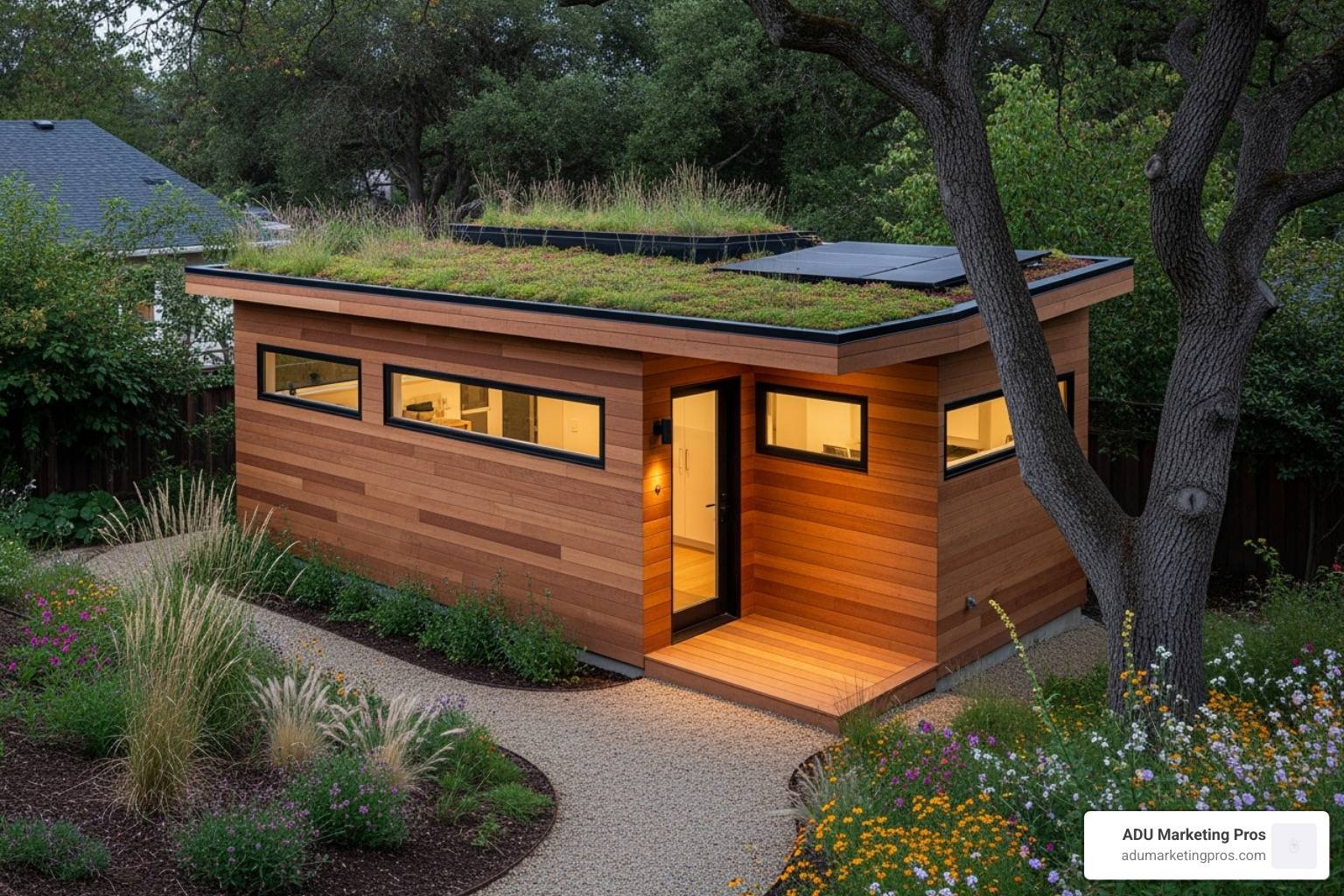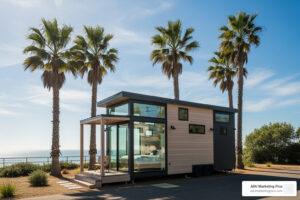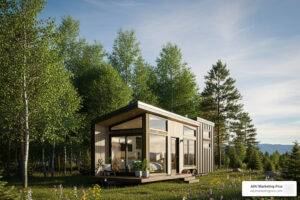Why Sustainable ADU Designs Are the Future of Smart Housing
Sustainable ADU designs are a smart blend of environmental responsibility and financial wisdom, creating accessory dwelling units that benefit both homeowners and the planet. These eco-friendly units offer three key advantages:
Environmental Benefits:
- 12x fewer CO2 emissions with solar panels vs. natural gas
- Reduced material consumption and waste
- Lower overall energy consumption
Financial Benefits:
- Up to 35% increase in property value
- $1,500+ annual savings on electricity bills with solar
- 72% reduction in energy bills with geothermal systems
Health & Social Benefits:
- Improved indoor air quality with non-toxic materials
- Support for multigenerational living
- Contribution to affordable housing solutions
With an estimated 1.4 million legal ADUs in the U.S., demand continues to grow. Most ADUs are between 600 and 1,200 square feet, making them ideal for sustainable design principles that maximize efficiency and minimize environmental impact.
ADUs are a crucial solution to the housing crisis, increasing density without urban sprawl. However, a truly sustainable ADU stands apart through thoughtful design choices, from site orientation to smart home technology.
Going green with your ADU creates a more comfortable, cost-effective, and valuable property addition. For architects and builders, understanding sustainable ADU designs is essential to attract environmentally conscious clients and succeed in today’s market.

Sustainable ADU designs definitions:
The Triple Bottom Line: Why Go Green with Your ADU?
Choosing sustainable ADU designs delivers a triple bottom line: environmental stewardship, financial wisdom, and social responsibility. It’s about creating a structure that improves your life and makes a positive impact.
Environmental Perks
Sustainable ADU designs are inherently eco-friendly due to their smaller size, an advantage amplified by thoughtful choices. Features like solar panels significantly reduce your carbon footprint, producing 12 times fewer CO2 emissions than natural gas systems over the ADU’s lifetime.
Beyond energy, these ADUs minimize material use, land disturbance, and water consumption through efficient fixtures and smart landscaping. Choosing durable materials reduces future landfill waste, while features like rainwater harvesting and native landscaping support local ecosystems.
Financial Gains
Sustainable design offers compelling long-term financial benefits, despite some higher upfront costs. Adding an ADU can increase the overall value of a property by as much as 35%, according to a study conducted by the National Association of Realtors. A sustainable ADU often commands an even higher premium.
The monthly savings are significant. Solar panels can save households approximately $1,500 per year on electricity bills. Opting for geothermal heat pumps can reduce energy bills by as much as 72% compared to standard air conditioning units, according to the DOE.
High-performance insulation, energy-efficient windows, and smart tech all contribute to lower utility costs. Furthermore, green building features often qualify for rebates and tax credits, while durable materials save on future repairs.
For more detailed guidance on planning your investment, check out more info about ADU building plans.
Social and Health Advantages
Sustainable ADU designs also create healthier, more comfortable living spaces. Choosing non-toxic materials and low-VOC paints dramatically improves indoor air quality by eliminating harmful chemicals, which is crucial in smaller spaces.
Strategic use of natural light saves energy and boosts well-being, while proper ventilation ensures fresh air without energy waste.
Socially, these units enable multigenerational living, allowing families to stay close while maintaining independence. They can also provide affordable workforce housing and, with aging-in-place design, offer safe, accessible long-term living solutions. Finally, sustainable landscaping connects residents to nature, creating a healthier way of living.
Blueprint for a Better Backyard: Core Principles of Sustainable ADU Designs
A truly sustainable ADU begins with a thoughtful blueprint integrating eco-conscious principles. This section covers the fundamentals, from site selection to material choices. We are specialists in Accessory Dwelling Unit Design, ensuring every project meets the highest standards.
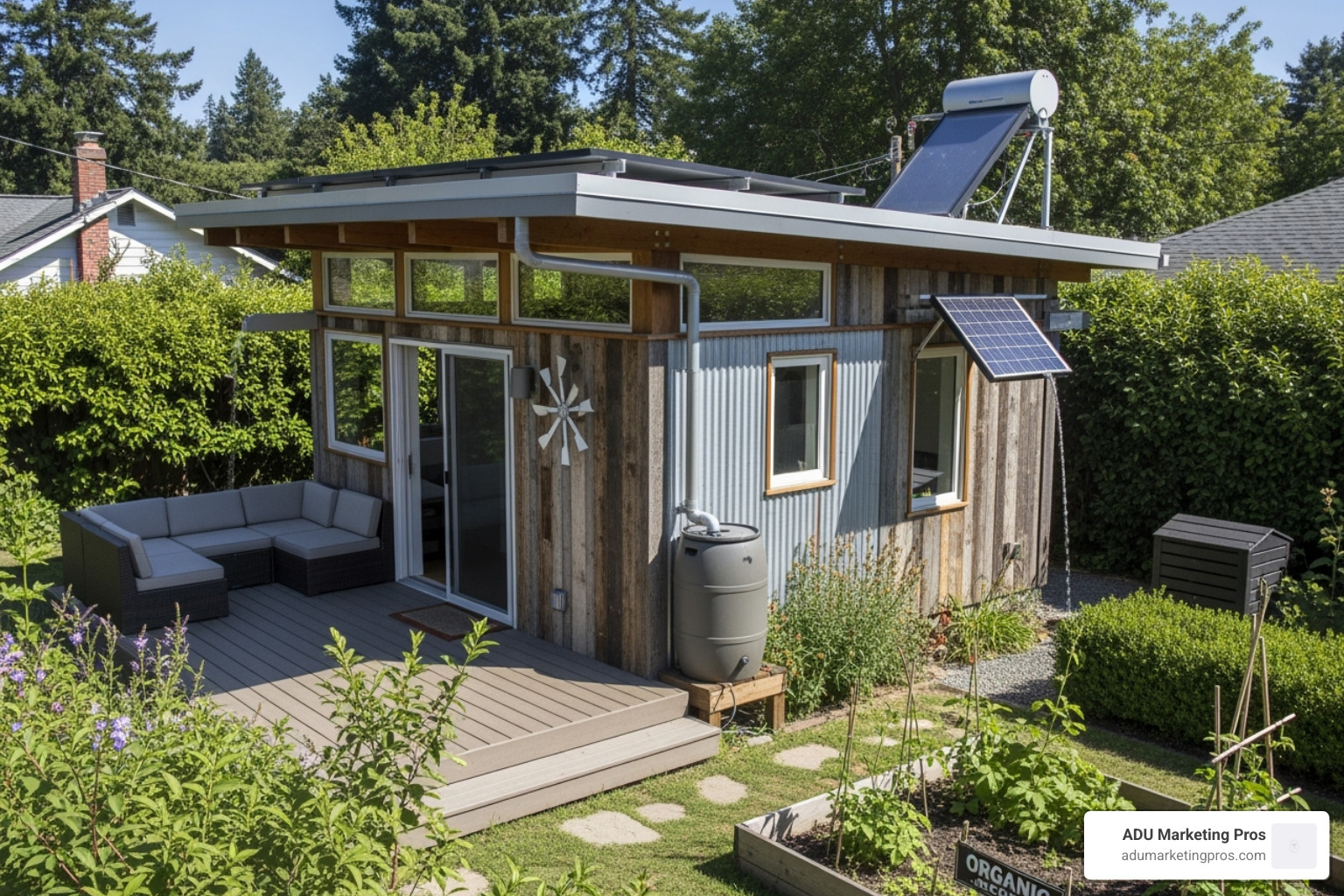
Site Optimization and Passive Design
Careful site optimization is the first step. The ADU’s placement on your property significantly impacts its energy efficiency and comfort. We analyze solar orientation and prevailing winds. Maximizing south-facing windows provides passive solar heating in winter, while strategic shading from overhangs prevents overheating in summer, reducing reliance on AC. Cross-ventilation, achieved by placing windows on opposite sides, naturally cools the interior.
Maximizing natural light with windows and skylights is crucial. Daylighting can reduce an ADU’s energy loads and utility bills by anywhere from 20 to 60%. Thoughtful landscaping, like using deciduous trees for seasonal shade, also plays a key role. For more about passive heating, Learn more about building or retrofitting for passive heating here..
The Building Envelope: A Deep Dive into Insulation and Air Sealing for sustainable ADU designs
The building envelope (roof, walls, windows, doors) is key to sustainable ADU designs. A high-performance envelope minimizes heat transfer, dramatically cutting energy use. High-performance insulation is crucial, and we select materials with a high R-value, including eco-friendly options like recycled denim, cellulose, or hempcrete.
Air tightness is equally important. We carefully seal all gaps and cracks, as air leakage can account for up to a third of a home’s heat loss. Energy-efficient windows and doors are also critical, since approximately 30% of a home’s heating and cooling energy is lost through its windows and doors. We recommend double or triple-pane windows with Low-E coatings and energy-efficient doors. Cool roofs, made of reflective materials, also reduce heat absorption in sunny climates.
From Foundation to Furnishings: Choosing Eco-Conscious Materials
Material choice profoundly impacts sustainability, from embodied carbon to indoor air quality. We prioritize durable, beautiful, and environmentally responsible materials.
Here’s a list of sustainable building materials we often consider:
- Reclaimed wood
- Bamboo flooring
- Cork flooring
- Recycled steel
- Recycled glass countertops
- Low-VOC or no-VOC paints and finishes
- FSC (Forest Stewardship Council) certified lumber
- Locally sourced materials
We also seek “Red List-free” materials, which are free of harmful chemicals. Durability is key to reducing waste. We also encourage using reused and upcycled furnishings from places like Habitat for Humanity ReStores to add character and reduce environmental impact.
Powering Down: Active Systems for an Energy-Efficient ADU
While passive design is the foundation, active systems bring your sustainable ADU designs to life. These efficient, smart systems provide heating, cooling, and power, keeping you comfortable while minimizing your environmental impact and utility bills. The gold standard is the all-electric home. Eliminating gas slashes your carbon footprint, improves indoor air quality by removing combustion byproducts, and simplifies maintenance. We are experts in creating an Energy-Efficient ADU that maximizes these benefits.
High-Efficiency HVAC and Water Heating
Heat pump water heaters and air source heat pumps are game-changers, up to three times more efficient than traditional appliances because they move heat rather than creating it. Ductless mini-split systems are ideal for ADUs, offering efficient, zoned heating and cooling to prevent conditioning unused spaces.
For added comfort, radiant floor heating offers luxurious, consistent warmth. Energy recovery ventilators (ERVs) provide fresh air while recovering up to 95% of the heat from outgoing air, saving significant energy. Where applicable, geothermal heat pumps are transformative, and can reduce energy bills by as much as 72% compared to standard air conditioning units, according to the DOE.
Appliances, Lighting, and Smart Tech
Every appliance and light fixture is an opportunity to save. We recommend ENERGY STAR appliances, including efficient refrigerators and heat pump dryers. Induction cooktops are highly efficient, offer precise temperature control, and keep the ADU cooler.
LED lighting is a must-have, operating up to 90% more efficiently and lasting much longer than traditional bulbs. We use 100% LED lighting in our designs.
Smart home technology offers further savings. Smart thermostats learn your routines to avoid heating or cooling an empty ADU, while energy monitoring systems provide real-time consumption data. Automated lighting with motion sensors and leak detection sensors further improve efficiency and prevent waste.
These innovations contribute to creating truly intelligent and efficient ADU Design Innovations that make your life easier while protecting the environment.
Dollars, Permits, and Professionals: Planning Your Green ADU Project
A sustainable ADU designs project requires balancing dreams with reality, understanding regulations, and finding the right team. While some green features have higher upfront costs, the real story is the long-term return on investment.
Understanding the Costs and Savings
Long-term savings from sustainable features are significant. For example, geothermal heat pumps can cut energy bills by up to 72% (DOE), and solar panels can save around $1,500 annually. These savings compound over time.
We help clients calculate the payback period for green features, which is often surprisingly short. Many features also qualify for rebates and tax credits, reducing upfront costs. Check the DOE’s website for federal programs, and look for local incentives. Beyond utility savings, a sustainable ADU increases property value, making it a sound financial investment.
Navigating Regulations and Finding the Right Team
ADU regulations can be complex. Zoning laws and building codes vary by location, so understanding local requirements is crucial. In California, new ADUs are typically subject to energy code requirements for solar panels and must comply with Title 24 energy standards and CalGreen building codes. For more detailed information on how Title24 and CalGreen energy codes impact ADUs, see this webinar.
The permitting process requires submitting detailed, compliant plans. An experienced team is invaluable. We recommend working with architects who specialize in sustainable ADU designs to steer design complexities and regulatory requirements. Vetting contractors with sustainable construction experience is also critical. Proper installation of green features is essential for performance, making specialized knowledge the key to a successful project.
If you’re considering converting an existing structure, our insights on Garage to ADU Conversion can provide valuable guidance.
Water-Wise Living: Conservation Strategies for Your ADU
Water conservation is both environmentally responsible and financially smart. The EPA estimates that the average household wastes 180 gallons of water per week, so there’s huge potential for savings. In sustainable ADU designs, we implement water-saving strategies indoors and out.
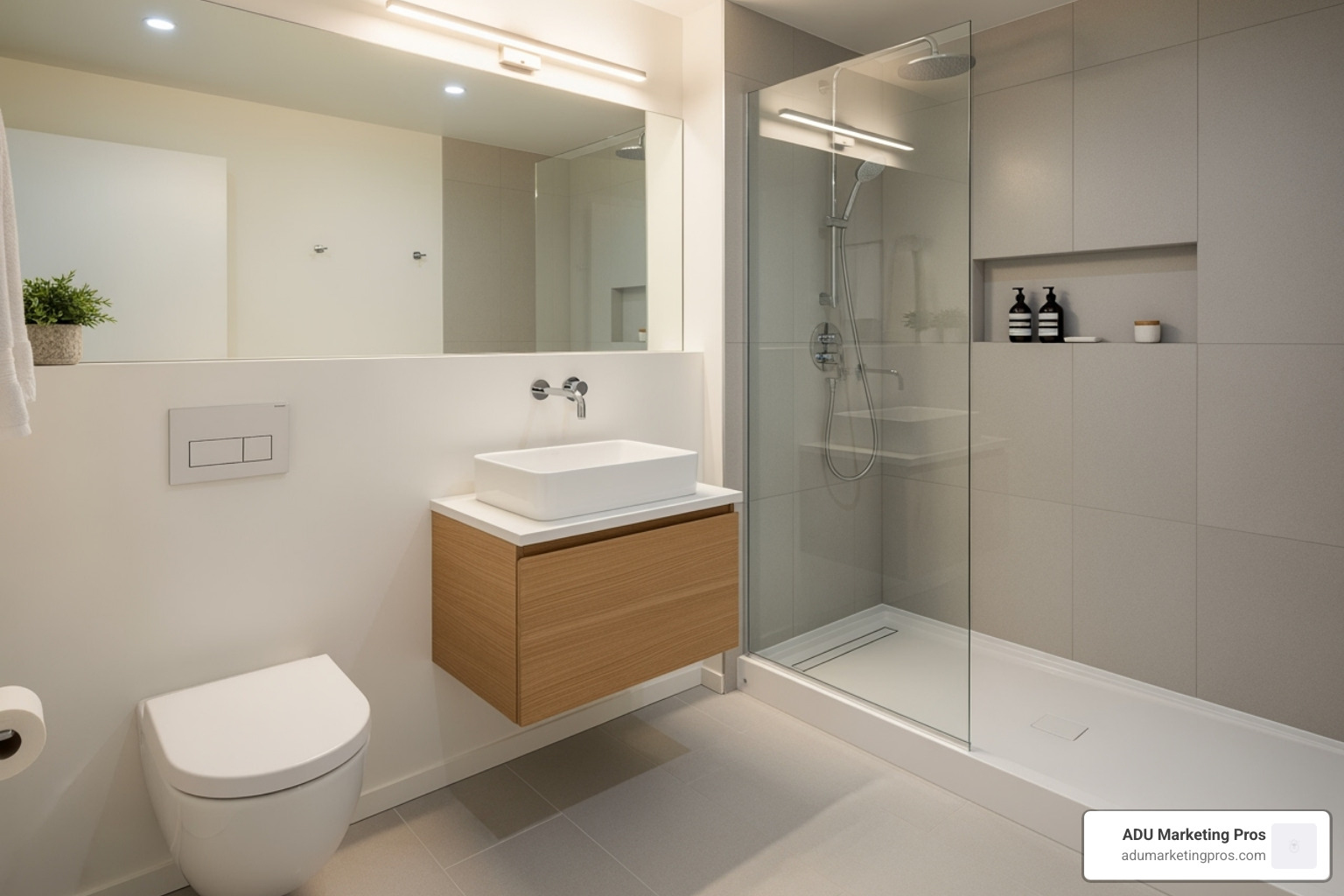
Fixtures, Appliances, and Plumbing Solutions
The kitchen and bathroom are primary areas for water use. We prioritize efficient fixtures, starting with low-flow toilets. WaterSense-certified toilets use as little as 1.28 gallons per flush. For showers, standard shower heads typically use 2.5 gallons of water per minute, while WaterSense low-flow showerheads use no more than 2 gallons per minute, saving a household thousands of gallons annually. WaterSense-certified faucets reduce flow by at least 30%.
ENERGY STAR dishwashers are also key, using far less water than older models and even less than hand washing. Smart plumbing solutions like pressure-reducing valves and hot water recirculation pumps also conserve water by lowering pressure and providing instant hot water, eliminating waste.
Outdoor Water Use
Outdoor water use for landscaping is a major concern. Our designs prioritize strategies that work with nature. Rainwater harvesting systems, from simple rain barrels to larger cisterns, collect roof runoff for irrigation. Greywater systems recycle water from sinks and showers for landscape irrigation, further reducing outdoor water needs.
Landscaping choices are critical. Drought-tolerant native plants are adapted to the local climate, requiring minimal irrigation once established. When irrigation is needed, drip irrigation is a highly efficient method that delivers water directly to plant roots. Finally, permeable paving for walkways and driveways allows rainwater to soak into the ground, recharging groundwater and reducing stormwater runoff.
Conclusion: Build a Better Future in Your Own Backyard
Building a sustainable ADU is more than adding square footage; it’s a conscious choice to create a home that benefits you, your family, and the environment. It’s an investment in a lasting legacy. The beauty of sustainable ADU designs is their ability to merge priorities: they lower utility bills, can increase property value by up to 35%, and improve health with non-toxic materials and cleaner air.
The numbers are clear: with potential for $1,500 annual savings on electricity bills, 72% reductions in energy costs with geothermal systems, and significant property value increases, the financial case becomes crystal clear. These benefits compound over time, delivering lower bills, healthier air, and a smaller carbon footprint.
ADUs are reshaping American housing, offering solutions to the affordability crisis. With 1.4 million legal ADUs already in existence and growing demand for housing alternatives, sustainable design isn’t just nice to have—it’s essential for staying competitive in today’s market.
The future of housing is happening right in our backyards. As regulations evolve and homeowners become more environmentally conscious, the firms that understand sustainable ADU construction will be the ones thriving. Whether you’re designing your first ADU or your fiftieth, embracing these principles positions you at the forefront of an industry change.
That’s where specialized marketing becomes crucial. At ADU Marketing Pros, we help builders and architects showcase their expertise in sustainable ADU designs to connect with homeowners who understand the value of eco-friendly construction. We know that when you can demonstrate your knowledge of everything from passive solar design to smart home integration, you attract clients who appreciate quality over the lowest bid.
Ready to position your firm as the go-to expert for sustainable ADU construction? Explore our ADU marketing solutions to grow your business and start attracting the high-quality leads that fuel sustainable growth.

